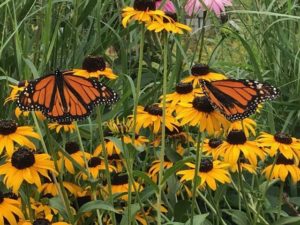
If you’re an avid gardener, you probably like to tend to your garden in the morning hours while it’s still cool. And if you’ve ever worked out under the hot sun or did any sports or other physical activity, you know how quickly you sweat and need to hydrate. Well with temperatures on the rise this month, it is important to know just how much water your plants need to stay healthy too.
Know When to Water, Know When Not to Water
If you play poker, you’ve probably become well-versed at reading the faces of your fellow players to know whether or not they’re bluffing. Well, our garden specialist Shelly, who you may know from our Tip Tuesday videos, says that you can learn a lot by reading your plants. Let them tell you what they need. With the heat index on the rise, watch for signs that they need more water or have had too much. To watch Shelly’s Tip Tuesday video, click here.
- Make sure leaves are a nice dark green color.
- Watch for drooping, curling or wilting of leaves that could mean plants are not watered well enough.
- Watch for spots or yellowing of your plants’ leaves that indicate moisture stress. That can be caused by overwatering or underwatering. Be sure to feel the soil.
- Watch out for root rot, which is primarily caused by poor drainage of damp soil, overwatering or a poorly functioning root system. Prolonged exposure to excess water causes waterlogging, which interferes with aeration of the roots. Plants in soils too dense for water to drain out efficiently, or in containers that lack sufficient drainage holes, are most susceptible to root rot.
Be Consistent with Your Water Schedule
Shelly says to water plants in planters every day or every other day, depending on rainfall.
Plants that are in the ground should be watered, on average, every two to three days, or twice a week (depending upon rainfall) because they’re also getting water from the soil. Shelly says that watering is especially important the first season you plant them in the ground but after that, once the plant is established, you shouldn’t need to water much again with the moisture they get from the soil and rainfall.
Moisture Profile of Some Popular Plants
A bit on the thirsty side:
Coneflowers tend to prefer more water. As Shelly says, read the plant to see how it’s doing. Are its leaves droopy? Check how moist the soil is.
Spiderworts like moisture too. This beautiful native perennial of Pennsylvania does well along ponds, or in areas of your yard with not-so-good drainage, such as along the foundation. They have a small root system. They’re a pretty easy-going plant because they can handle sun and shade.
Here’s a list of a few more plants that can handle moist conditions:
- Lily of the valley
- Bugbane Crinum
- Sweet woodruff
- Daylily
- Rose mallow
- Blue vervain
- Monkey flower
- Iris
On the dryer side:
Seedum, with its rubbery leaf, and other plants from the stone crop family like it hot. They like a dry rocky region and don’t like a lot of water, even in pots.
These are some additional plants that can handle dryer conditions:
- Phlox
- Succulents
- Black-eyed Susan
- English Lavender
- Catmint
- Yarrow
If you are new to gardening or you are thinking of adding more to your garden next season, you might want to first consider what the soil conditions and drainage is like in your yard and consider the profile of a plant (whether it prefers dry or moist conditions more) before purchasing and planting. As always, Shelly and the team are here to help you when you visit the garden center.
So, remember to hydrate…yourself and your plants properly this summer so you’ll all be able to enjoy this season!

